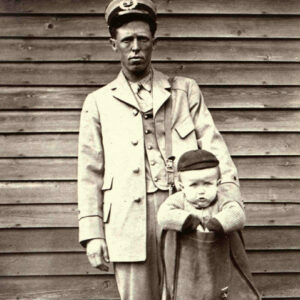There’s no denying these are tough times for the U.S. Postal Service. Thanks to email and bills being delivered and paid online, stamp sales are way down while operating expenses are way up, resulting in billions of dollars of debt.
In the early 20th century, the Postal Department was looking for ways to expand its services. And what it came up with — or, at least, how folks used it — will surprise you.
First, the back story.
The Continental Congress created the U.S. Post Office in 1775 (with Ben Franklin as the first postmaster general). In 1792, it became the Cabinet-level Post Office Department. For the next 121 years, it did a credible job of delivering mail — you know, the whole “Neither snow nor rain nor heat nor gloom of night …” bit.
During that time, the Postal Department focused on delivering letters. Newspapers (it cost a penny to send one within 100 miles and 1.5 cents beyond that) were also carried. Starting in 1845, local papers were sent for free. Then, in 1852, magazines got the same sweetheart penny rate newspapers enjoyed.
That was essentially it: letters, magazines and newspapers. If you wanted to send a parcel, you had to send it via a shipping company. Adams Express was the FedEx and UPS of the 19th century. Wells Fargo was another major carrier.
Americans benefited from reading all those publications they could now receive at home, but the Postal Department didn’t. Sending printed material at rock-bottom rates was taking a big bite out of its bottom line.
In 1913, Postmaster General Frank Hitchcock came up with an idea to offset that expense. He thought his department should have a piece of the package delivery action.
Hitchcock was an innovative executive. He pioneered airmail service, made mail fraud prosecution a priority, and even started “Operation Santa Claus,” where postal workers replied to children’s letters to jolly old Saint Nick.
Parcel service began January 1, 1913. Though the idea was forward-thinking, Hitchcock leaped before he looked. While the Postal Department had set rates for package delivery, its bureaucrats immediately ran into an unintended consequence.
They didn’t specify what items could and couldn’t be sent by Parcel Post.
Americans used the new service with gusto. Farmers mailed live bees. College students mailed their laundry home to their mothers. (That much hasn’t changed in the last century.)
And in several cases, some families even sent their children by mail. No, really, they did.
The first known case was reported in Ohio. Just weeks into Parcel Post’s availability, Jesse and Mathilda Beagle mailed their 8-month-old son James to his grandmother a few miles away. Fortunately for the Beagles, James weighed in just under the 11-pound weight limit. The postage cost them 15 cents, about $4.76 today. The couple took out $50 in insurance, just in case.
Baby James arrived safe and sound. It was such a novelty that it inspired human interest newspaper stories, which in turn led to other tots “going postal.”
The most celebrated incident occurred on Feb. 19, 1914, when 4-year-old Charlotte Mary Pierstorff was “mailed” nearly 75 miles to her grandparents in Grangeville, Idaho. The trip became so famous that it was turned into the children’s book “Mailing Mary” by Michael O. Tunnell.
(That particular case wasn’t as cold-hearted as it may sound. Train tickets weren’t cheap in those days, and the family apparently economized by shipping the child by Parcel Post. A relative worked as a railway mail service clerk and accompanied her on her journey.)
It didn’t take long for the Post Office’s big brass to realize the practice could lead to serious trouble. Major newspapers reported on June 13, 1913, that Hitchcock put the kibosh on sending kids via mail. (Though in little Mary’s case the following year and in several others, it appears mailmen turned a blind eye to the decree and let little ones pass through the mail anyway.)
Though the practice didn’t last long, it is a colorful footnote to the Postal Service’s fabled past — the one brief shining moment when C.O.D. could have stood for Child On Delivery.
Please follow DVJournal on social media: X@DVJournal or Facebook.com/DelawareValleyJournal

